London has lost a number of stations on the rail network over the years, for example I have written about Spa Road Station in Bermondsey, but they are usually stations serving trains that pass through the station, rather than a terminal station. One lost station that was a terminus for the North London Railway was Broad Street Station.
The station was demolished in 1986, and just as work was about to start, I took a couple of photos of the front and side of the building from Liverpool Street.
The station was replaced by the Broadgate office complex. The following photo shows the same view today:
The history of Broad Street Station starts in 1850 when the North London Railway started running services between Camden Town and Poplar.
The line was extended, firstly to Hampstead in 1851 and in 1858 this was followed by a connection with the London and South Western Railway to Richmond.
Although the railway circled around north London, it did not have a route into the City, and a City terminus was seen as essential to drive additional goods and passenger traffic from the expanding northern suburbs. The extension into the City and Broad Street Station was opened in late 1865 as the central London terminus of the North London Railway.
An indication of the volume of different types of traffic carried by the railway can be found from the directors report of the North London Railway in 1865, covering the year before the opening of Broad Street Station:
The higher value and greater increase over the previous year of Merchandise and Minerals than Passengers perhaps reflects the importance of the connection with the London Docks, and the lack of a connection directly into the City of London.
In the same Directors Report, the chief engineer for the extension to Broad Street states the current situation with construction of the station, and the route between Broad Street and the existing North London Railway at Kingsland:
“I have now the pleasure of being able to report that the whole of the works on the City Branch, between Kingsland and Broad-street, are complete, with the exception of the permanent way and signals, upon which the contractors are at present busily engaged. The stations at Dalston and Shoreditch are nearly ready for occupation, and the office-buildings, platforms and roofs at Broad-street station have made considerable progress since February last, but recently these works have been retarded by the strike amongst Messrs. Cubitt’s workmen, Every effort is being made to open this railway for public traffic at the earliest possible period”.
Broad Street station and the route into the station was sufficiently completed to open in the last months of 1865, and the following year the North London Railway company was able to advertise special trains which took advantage of the route around north London and down to the west:
“NORTH LONDON RAILWAY – OXFORD and CAMBRIDGE BOAT RACE. Saturday, March 24th, 1866 – A SPECIAL TRAIN will leave Broad Street Station at 6.35 a.m. for Hammersmith, calling at all intermediate stations and arriving at Hammersmith at 7.40 a.m.”
Broad Street station was built in the heart of the City, and provided a route for passengers and goods from multiple stations circling north London. The location of the station was directly to the west of the larger Liverpool Street Station.
The following map from 1940 shows the location of Broad Street Station:
Liverpool Street Station rail tracks headed east, whilst Broad Street’s headed north with the first stop being the original Shoreditch Station on the north west corner of the Kingsland Road / Old Street junction.
My second photo of the station again shows the main building of Broad Street Station, slightly further to the east than the first photo. The road that dived down between Broad Street and Liverpool Street stations can be seen running down alongside Hills, whilst in one of the open arches to the right of the station, an orange crane can seen, working on the station’s demolition.
The 1865 directors report demonstrated the significant value of goods being transported on the North London Railway, and whilst new passengers were an important source of revenue for the new Broad Street Station, the transport of goods directly into the City would also continue to drive revenue for the railway company.
A large Goods Station was constructed to the west of the passenger station as can be seen in the following extract from the 1894 Ordnance Survey map (‘Reproduced with the permission of the National Library of Scotland’):
The map also shows the relative size of Broad Street compared to the adjacent Liverpool Street Station. Liverpool Street was considerably larger with many more platforms.
The above map shows that the warehouses associated with the Broad Street Goods Station faced onto Eldon Street. The end of these warehouses came in January 1952 when a major fire destroyed the warehouses. It was the most significant fire in London since the war and three firemen lost their lives following a collapse of one of the warehouse walls.
The loss of the warehouses added to the general sense that Broad Street Station was in a terminal decline.
The peak of the station’s success was probably around the time of the above Ordnance Survey map, at the end of the 19th century. North London was being well served by underground routes, buses and trams, and the popularity of Broad Street Station, on the end of a relatively slow, stopping route, was in decline.
The station, and the lines running out of the station were damaged by wartime bombing and the reduction of local services started with the cessation of trains to Poplar. The station building was not repaired and much of the main building was closed in 1950, leaving just an entrance from the street onto the concourse. Just two platforms continued to operate.
The following photo from the Britain from Above archive, shows the station and the lines running out of Broad Street in 1947. Broad Street passenger station is in the lower centre of the photo. The tracks for the goods station are on the left with the goods warehouse on the left of the photo. The larger Liverpool Street station is on the lower right.
Broad Street station survived the Beeching Report, however the stopping services that ran into the station were identified as services for modification, and the gradual cease of services accelerated throughout the 1960s and early 1970s.
Plans for the demolition of the station started in the 1970s and a number of schemes were put forward for the use of a considerable area of prime land at the eastern edge of the City’s business area.
In 1975, British Rail proposed a scheme that would not only demolish Broad Street Station, but would also demolish the Great Eastern Hotel and the cast iron train sheds above the platforms of Liverpool Street.
Liverpool Street as a station would remain, but the station, and the surrounding area, including the land occupied by Broad Street Passenger and Goods Stations would be built over, with office blocks now dominating the area.
The following photo shows British Rail’s 1975 scheme. The tracks running into Liverpool Street Station can be seen heading underneath a plaza and office blocks.
The Liverpool Street Station Campaign proposed an alternative solution which would retain most of the existing Liverpool Street Station, the train sheds and the façade of Broad Street Station.
Other campaigns were more concerned about the transport options than the architecture. For example, in 1982:
“Tory MP Anthony Grant and Harrow Liberal councilor Stephen Giles Medhurst have joined forces to try and make British Rail change plans to demolish Broad Street Station in the City.
The pair met BR representatives at the House of Commons to give their objections to the plan for Broad Street, which is the terminus for a frequent service from Watford Junction through Harrow and Wealdstone and Kenton.
Mr. Grant, MP for Harrow Central, said: ‘I am satisfied that in the long term the service will be maintained to Broad Street and Liverpool Street when the new station is built, but this will take six years.
Meanwhile, my constituents who work in the City will suffer hardship through being dropped off at a temporary station nearly half a mile away’.
Cllr Giles-Medhurst, a regular user of the line, said ‘I’m pleased to say that as a result of our meeting they undertook to reconsider improving the interchange facilities at Highbury to make it easier to change to the Moorgate line or to provide a shuttle bus service from the temporary station to Broad Street in peak hours”.
There had been earlier schemes for the redevelopment of Broad Street and Liverpool Street stations. In 1944 an exhibition at the Incorporated Association of Architects and Surveyors in Eaton Place hosted an exhibition of drawings by Mr. Kenneth Lindy and Mr. B.A.P. Winton Lewis showing their proposals for the re-planning of the City of London.
Their proposals transformed London into a future version from a science fiction film, and probably highlight the thinking at the time that the bombed City offered the opportunity for a sweeping change, with the car, towers and wide boulevards at the heart of the scheme. Their proposal for Broad Street and Liverpool Street stations is shown in the following drawing. The railway lines and platforms would move underground. Hotel and office buildings on top, and high above would be landing platforms for a gyroplane passenger service.
Thankfully, these 1944 proposals never got any further than the exhibition.
The eventual scheme for rebuilding involved the full demolition of Broad Street Passenger and Goods Station, but retained Charles Barry’s Great Eastern Hotel at Liverpool Street and part of the train sheds above the platforms of Liverpool Street station.
The go ahead was given in 1985 as reported by the Hammersmith and Shepherds Bush Gazette:
“Commuters lose rail link with the City – The final nail in the coffin of West London’s rail link with the City.
Secretary of State for Transport, Nicholas Ridley has agreed to the closure of the North London line between Dalston Junction and Broad Street stations.
The closure will come in May 1986, when Broad Street and Liverpool Street stations will be redeveloped. Commuters travelling from Acton and Chiswick will be among the first to be affected by the change.
From next Monday, May 13, their service will be diverted from Broad Street to North Woolwich. Passengers bound for the City will have to change at Islington and Highbury. There will be no through rail link from West London to the City”.
The Conservative government of the 1980s did not seem very supportive of the railways. It was the same Nicholas Ridley who in 1985 oversaw bus deregulation and the privatisation of bus services. There was even talk of closing rail lines and using the routes for dedicated bus services. I remember one TV commentator at the time suggesting that if they did this, with the number of buses needed to bring commuters into London, it would soon be recognised that it was more efficient to connect all the busses together and run them on a dedicated track.
The Broadgate office complex was built over the land once occupied by the Broad Street stations.
The original North London Line is now part of the London Overground network.
The empty concourse of Broad Street Station as it would frequently appear in 1975.
Where did the name Broad Street come from as the station faced directly onto Liverpool Street?
Broad Street originally ran from London Wall to Threadneedle Street. An extension up from London Wall was named New Broad Street. The whole street today is called Old Broad Street.
I have marked the location of the passenger and goods station on Rocque’s map of 1746 and we can see New Broad Street extending up to the corner of the station and Broad Street Buildings running under where the main station building would be constructed.
The front of the main station building was over an interesting feature – Bethlem Burying Ground.
This was the “New Churchyard” which opened in 1569 and later became known as the Bedlam or Bethlem burying ground. The burial ground was used for well over 100 years, finally closing for burials in 1739.
The graveyard was disturbed during the construction of Broad Street Station, however no archaeological investigation was carried out. This was the mid 19th century and the City’s churchyards were being emptied as quickly as possible due to the conditions of these places in a growing City.
In parallel to the demolition of Broad Street Station, the Museum of London Department of Urban Archaeology carried out a detailed investigation with according to the museum’s web site “Several hundred skeletons were reburied on site and a sample c. 400 individuals were retained for research”.
The site has again been investigated as part of the preparations for Crossrail, and 3,300 burials were uncovered. Testing of five of the skeletons identified the plague pathogen, apparently the first time that plaque DNA from the 16th and 17th centuries has been identified in the UK.
In my 1986 photo at the start of the post, there is a busy road in front of Broad Street Station. This road was closed off for a few years as a work site for Crossrail. Liverpool Street will be one of Crossrail’s stations, so although Broad Street Station is long gone, the area continues to be an important transportation hub.

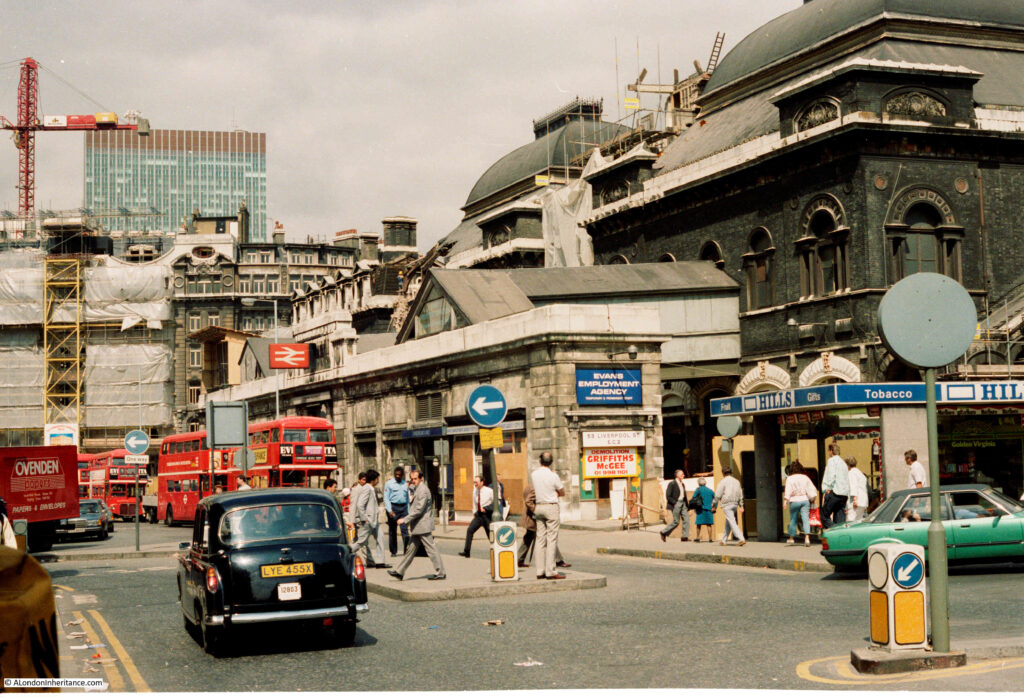
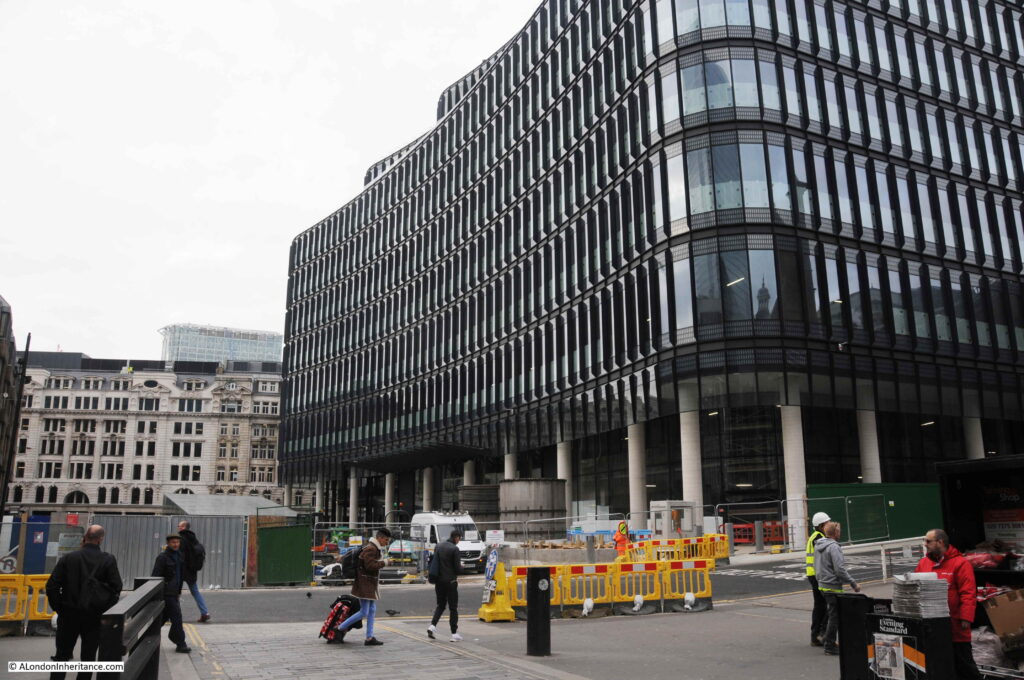
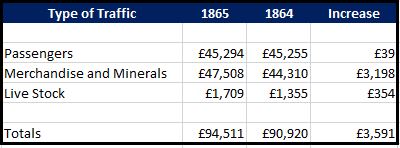
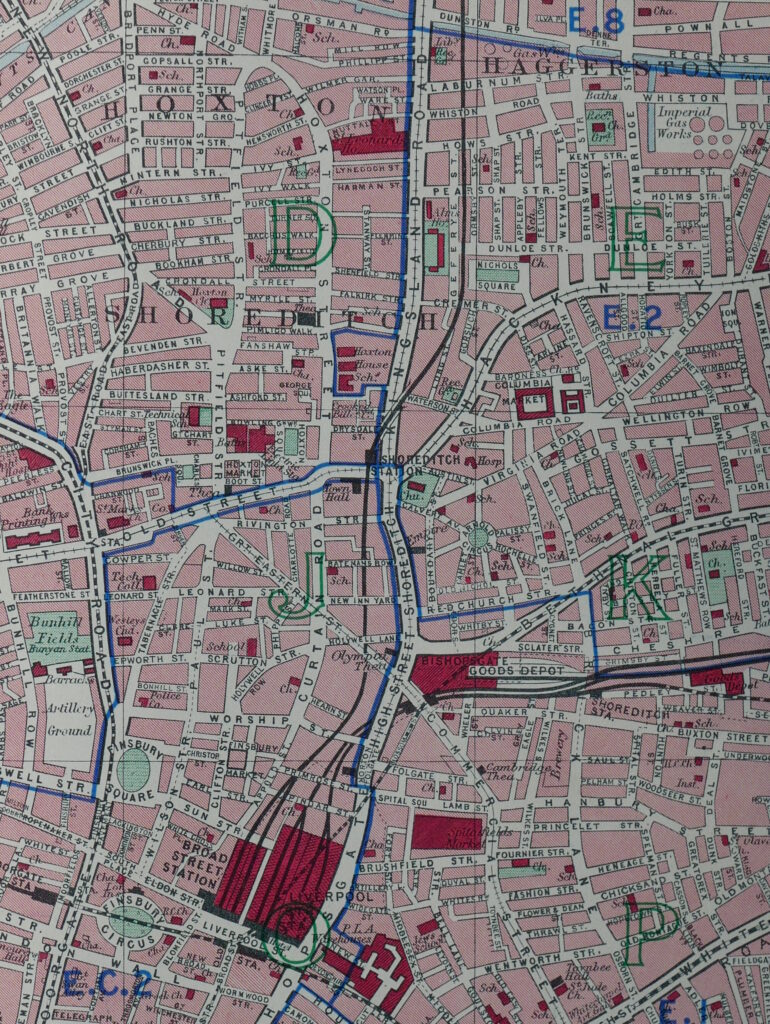
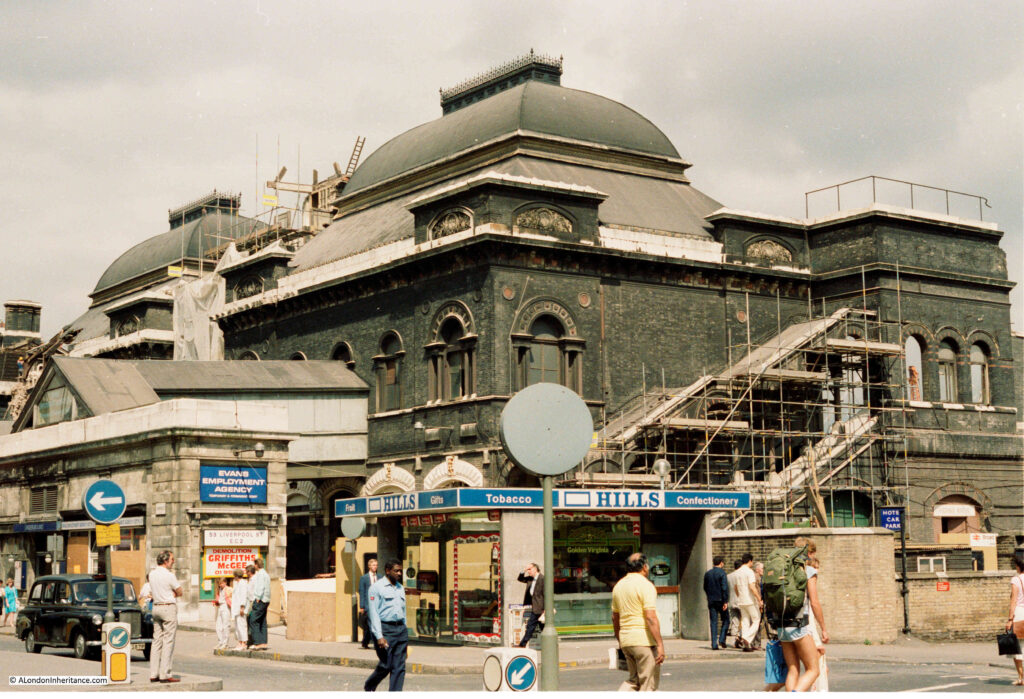
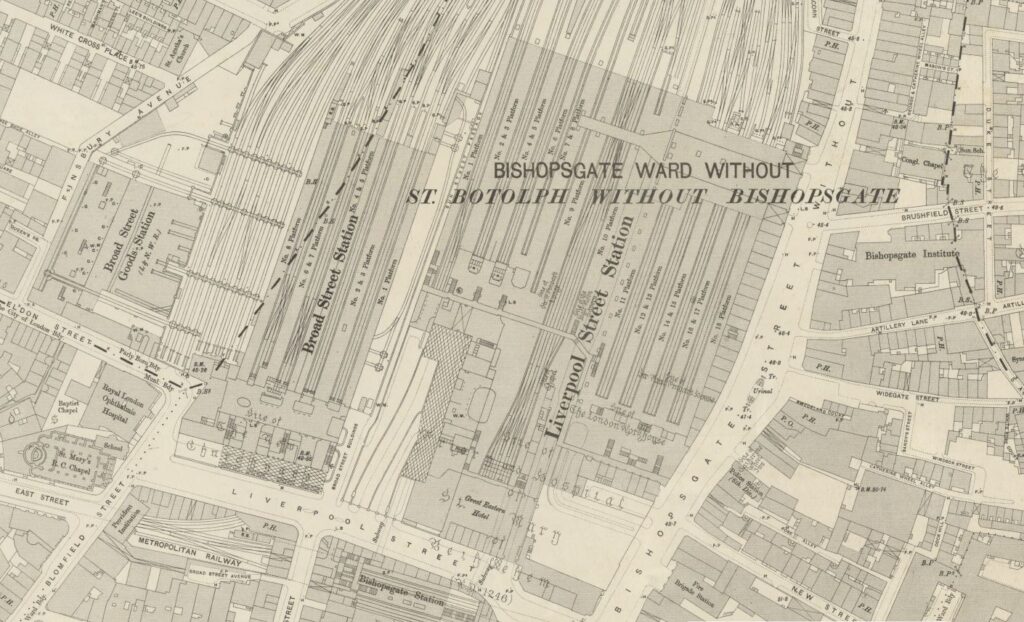
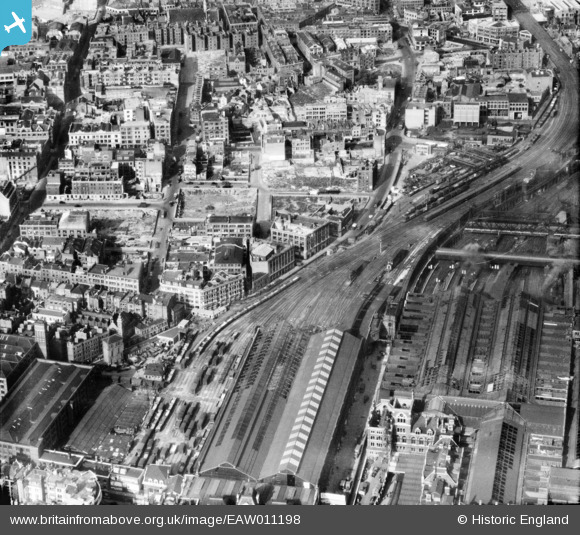
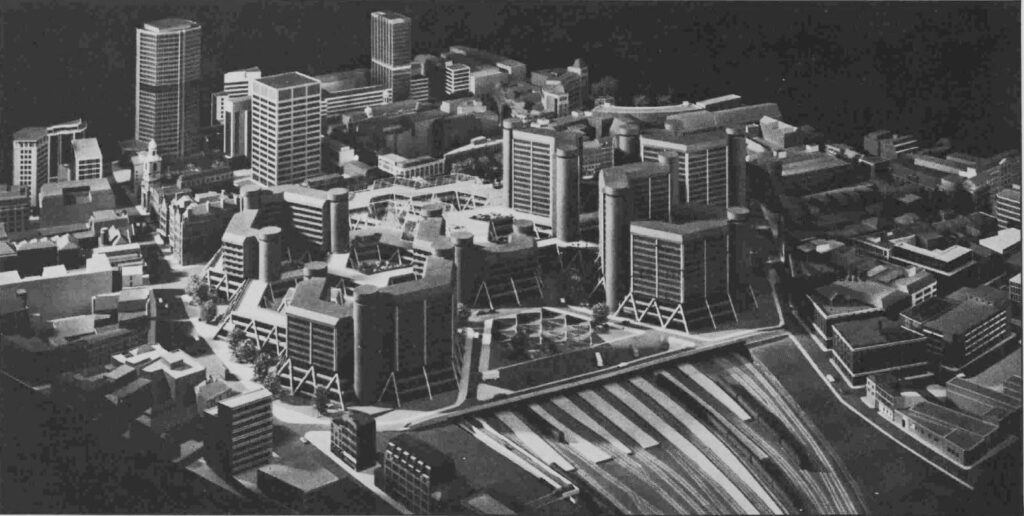
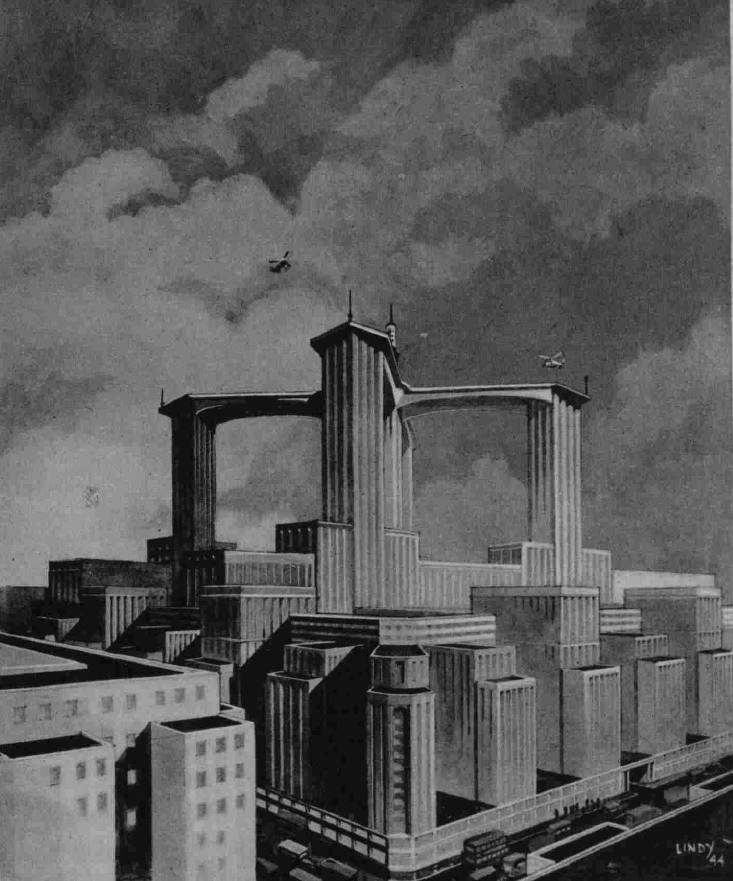
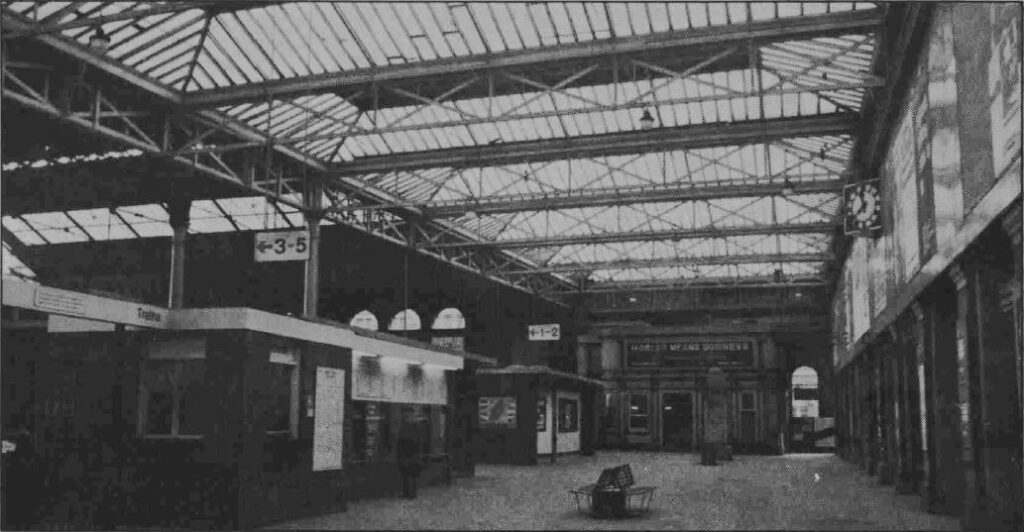
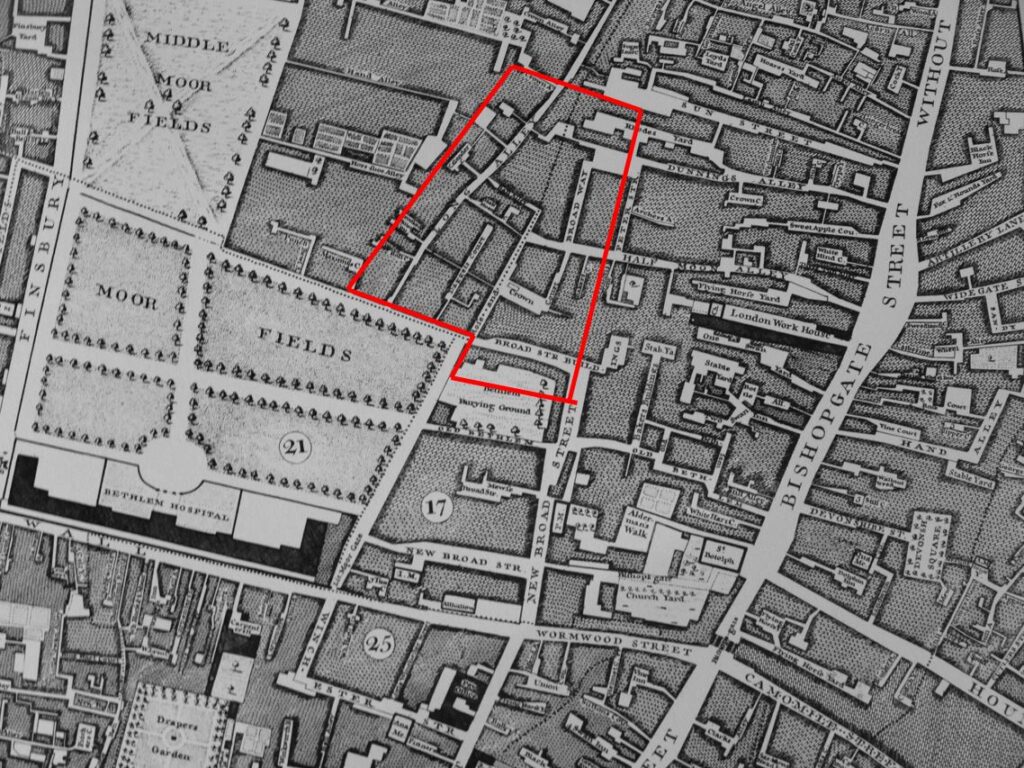
Thanks for another great post. I started work in 1979 in offices backing onto Finsbury Avenue, from where I watched the demolition of the goods handling buildings forming the west part of the Broad Street station complex – these were constructed so that goods wagons could enter at first floor level to discharge and the demolition crew had a tough job removing the network of riveted girders which formed the base of the first floor. Great spectator sport for a not over-busy trainee!
I lived in west London at the time, and although my normal route to work was via Waterloo and the ‘Drain’, I did on at least one occasion use the North London line from Broad Street to Richmond – a very underused and slow service.
“The Broadgate office complex was built over the land once occupied by the Broad Street stations.” Yes and no! It began with Finsbury Avenue Square, which was a stand-alone development built over a car park to the west and north of the site of Broad Street station’s goods yard, bounded by Eldon, Wilson and Sun Streets. Its first block as finished in 1984. It was then expanded onto the station site, and Broadgate proper started too… The name was chosen to imply it had been one of London’s ancient gates.
The graased over viaduct into/out of Broad St used to feature prominently in aerial photos but there is almost none left now.
Gone but not forgotten! My father used to take for long walks around the then deserted City on Sundays in the late 1960s and we’d get a train from Gospel Oak to Broad Street. I was sad when the pulled it down. I have some photos taken on the platform I believe. I’ll see if I can find them.
I left London in 1972, and for years before I used Liverpool Street station regularly from my home in Edmonton. I travelled each day to Blackfriars either by tube or bus.
I very much enjoy reading your post each weekend, informing me about some of the London that I am familiar with, but also teaching me about the areas I do not know. Thankyou, I look forward to your future posts.
A lot of work went into this…. well done …give my regards to Broad Street
I started work in the city in 1969.i used to walk up the taxi rank from Liverpool Street Station, cross Liverpool Street and cut through the arcade which contained the entrance to Broad Street. There was a Very small, “metro-tyoe Boots ( not that common at the time), a flower shop and a key cutters as I recall. Can’t believe that was 50 years ago!
Great piece, alondoninheritance, thanks. Particularly loved the research leading up to the station’s construction and the earlier archaeological evidence,
Having all too briefly served over 27 million passengers back in 1902, famously making it capital’s 3rd busiest terminus, the tube’s radial network of services had clearly long rendered the North London’s more orbital route redundant. Perhaps most poignantly marked by disappearance of the scale model 4-4-0 engine, whose wheels went round if you put a penny in the slot, that John Betjeman wonderfully describes.
Though it is now unquestionably heartening that so much of the route has recently been so successfully resurrected and revitalised by the Overground development.
Wouldn’t have minded at least maybe 1 gyroplane arrival in the City though!
If you walk up Great Eastern Street from the A10 two old underground trains can be seen above on the right. This is where the line used to arrive at the terminus. On the left hand side there is still evidence of the line too
I believe Broad Street was once the 3rd busiest railway station in London.
Charing Cross station is a similar size.
Thank you for another well researched and factual account of changes that have taken place in London. Once again you have kept it objective. I however can’t help but express a loss everytime I read about the knocking down of Old London. We love antiques, we love to uncover the past, but when it comes to our built heritage so much is knocked down rather than preserved for the future.
Great read this and many thanks for your research and hard work.From 1973 to 80 I had the pleasure of living in Gunnersbury and briefly Brondesbury and used The North London Line daily to get to work at an outside catering company in Sun Street. Luxurious way to commute because I would often have a whole carriage to myself .That whole area to the side and rear of the station always had an almost rundown Dickensian seediness about it, which I loved by the way,evoking wonderful memories,the
Flying Horse.Weaver Arms,economical Italian suits in Curtain Road,the Dairy in Sun Street too,marvellous times and Happy Days,many thanks.
Very good piece. I also started work in 1969 and used to cut across from Liverpool Street. What changed have happened in that area.
Good account but you omitted to mention the short-lived diversion of Broad St trains into Liverpool St via the Graham Road curve, which was opened in the mid-1980s to cater for Watford Junction services. The service was withdrawn around 1992. The Graham Road curve is situated by Hackney Central Station where the Enfield/Cheshunt/Chingford lines crossed the North London. Both lines are part of London Overground now and have been very successful (pre-Covid). The short curve connection is only used for the occassional non-passenger train movement.
Another splendid article, and read with enjoyment. I witnessed the demolition but to my great regret never used the station.
In the second of our author’s 1986 photographs we see demolition underway. Yet, note the scaffolding behind ‘Hills’ shop. This part of the building, the Lombardic Staircase, isn’t being demolished it’s being dismantled. There’s another photograph of it at this address…
http://www.disused-stations.org.uk/b/broad_street/index51.shtml
It had been decided to preserve the staircase and it was taken-away carefully for re-erection elsewhere. But where? The preservation was well-publicised at the time but since then the structure appears to have disappeared. I wonder if anyone knows where it is now or what happened to it?
I love the atmospheric shabbiness in the photos of Broad Street in its last days, although it must have been pretty dispiriting for anyone using it regularly.
My father worked at Ĺloyd’s and often parked with countless others on what was the ruins behind the Broad St Station facade and Liverpool St before it was “updated”. I believe the film Elephant Man shows how Liverpool St used to be and it was truly terrible. There was a ramp going down into Liverpool St to the right and a ramp going to the left into Broad St. Tjere isn’t much remaining of how it was except for an ar arcade opposite with one shop remaining today if you want a taste of how it was.
As probably one of the last people ever to commute between Primrose Hill and Broad Street back in the 1970s, I was always fascinated by the history of the gloomy North London terminus. Not least because back towards the end of its heydays, prior to the Great War, it hosted a dining car express called ‘The City To City’ which ran daily between Wolverhampton and London. That the London & North Western Railway considered running a train to the heart of the city – rather than its Euston terminus – indicates just how economically strategic Broad Street station’s position was…
Yes, and the trains, apparently, had a typist on board to type letters for businessmen. Broad Street station was the saddest place in London. Deserted at weekends. Just a handfull of passengers would alight at the terminus and disappear into an empty City. It always seemed to be raining when I travelled thre.
Another great post, and fantastic research. I travelled from Broad Street to Highbury in around 1981, on my very first visit to Highbury, where I now live. Inremember the climb up the dilapidated but nevertheless grand Italianate staircase on the Liverpool Street side of the station, shown in your photographs.
I’m researching the history of the imposing Highbury and Islington station buildings from the 1870s, slightly after Broad Street and a different architect, but another statement of the (justified) confidence of the North London Railway at that time.
Incidentally I have a photograph (a still from a documentary) of Margaret Thatcher personally operating one of the bulldozers during the demolition of Broad Street. I’ll send it over when I locate it.
A great-uncle of mine set up house in the newly-built village of Hackney in 1863. He rented a lamp-manufacturing workshop in Commercial Street and I always imagined him travelling to work on a horse-drawn bus down Kingsland Road. I think now that perhaps the North London Line to Broad Street was what determined his choice of location. I visited the area about two years ago, hoping to find the site, but of course it was long gone.
Another great history lesson -thanks
A little known fact, in the 1970’s the British Rail Shipping Division, Sealink, had at least one portakabin type office on a platform at Broad Street station. I know because I used to work in it.! I think I was there 1975 – 1977 until I changed employers. Some of the staff were in offices at Liverpool Street station, but definitely some were on the Broad Street platform! I used to commute into Waterloo, get on the Drain and most likely walk from Moorgate. I can only remember the station was run down, I think the electric service was still running to Richmond, but of course it was so long ago now I can’t be sure.
A wonderful station and a great loss to the architecture and atmosphere of the area. I travelled in and out of this station a few times, most memorably on the London Ring Rail Tour that tried to bring attention to the possibility of an ‘M25’ of rail around London, from North Woolwich to Woolwich, via Richmond.
The goods wagons were serviced by an upper and a lower deck, with lifts to join the two.
It is just possible that the staircase, or parts of it, were acquired by the late Lord MacAlpine for his garden railway at Fawley, Oxfordshire.He collected all sorts of major architectural features in his estate.
I too remember the model engine on the concourse. Did it ever get to the National Railway Museum?
Finally, I have worked in one of the four (not two) underground carriages in Shoreditch. Quite a view.
Please see this link to the LNWR “City to City” express from Wolverhampton to Broad Street and return. The pic shows it running on North London Rly lines. Of interest was that it had a carriage fitted up as an open plan office and advertised as a “typewriting saloon” for the Black Country or Birmingham businessman and, presumably, his secretary. http://www.lnwrs.org.uk/Carriages/gallery.php?filenum=526
Broad Street wasn’t just the terminus of the North London Line. I recall that trains also ran in the 1960s to Hertford North via the Canonbury curve, prior to the upgrading of the Moorgate to Finsbury Park line. At that time the station was a ruin, but thar seemed normal then.
I also used Broad street at the end of it’s life, it was a ghostly and forlorne place with a vast train shed, and the trains had bars over the windows to ensure you did not stick your head out and contact a signal post, the impression given was of arriving in Limbo in a prison train.
There is an article at http://www.mernick.org.uk/thhol/camdento.html from “The Illustrated London News”, 15th November 1851, p. 603-604. detailing a journey from Fenchurch street via Bow and Victoria Park Junction on the north London line. This was presumably to have a London Terminus and generate revenue while Broad Street was being built.
It includes “Passing onward, through the verdant fields, we came to the retired village of Homerton” which cannot really said to be the case now.
I was a British Transport Police officer based at Liverpool Street Station 1968-70. It was an amazing place like a small town. Broad Street station was closed by then I think, but had quite a sinister atmosphere especially at night. Sun Street Passage ran between the two and was known locally as Sun Street Magistrates Court for the dispensation of summary justice! We had the Met on one side and City of London Bishopsgate on the other. Lots of memories of my time there. Thanks for your piece.
I’m glad others remember the model engine! (I think it’s in the Railway Museum in York by the way). When I was a child, living in Ilford, we made regular visits to my grandparents in Hatch End, Middlesex. So we took the train from Ilford to Liverpool Street and continued our journey from Broad Street. It had a very superior Ladies Waiting Room as I remember and I always had a couple of coppers for the engine too …
My route home was across Broad Street to Liverpool Street. One evening a cyclist was involved in a bad accident with a van just there , and the policeman on point duty at that crossing (!) left his post to attend to the cyclist and the van. He yellled at me to direct the traffic. At the age of 22 I tried to stop and start the traffic approaching the junction from all 4 directions , but I should have borrowed his helmet. I believe the traffic jam only lasted 2 days.
Oof, the older Tube building was far more attractive & interesting than the box that replaced it! Should’ve incorporated the older superior structure, not trashed it. New offices – apart from the Gherkin; that’s ok for the City – are always so depressingly ugly; like they’re in competition, & made to make people feel small & shut-out. Price of everything, value of nothing. Seems a shame, for history & aesthetics, & for local community, but many thanks for the article – the old station kind’ve lives on forever in the photos? 🙂